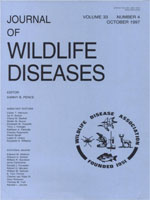An epizootic of duck plague occurred in early 1973 in a population of 163,500 wild waterfowl, primarily mallards (Anas platyrhynchos), wintering on Lake Andes and the nearby Missouri River in southeastern South Dakota (USA). The diagnosis was based on pathologic lesions and confirmed by virus isolation. Control measures included quarantine, attempts to reduce virus contamination of the area, dispersal of waterfowl, and monitoring of wild waterfowl populations for mortality. The epizootic resulted in documented mortality of 18% and estimated mortality of 26% of the waterfowl at risk. Prompt implementation of control measures might have limited mortality to approximately 8%. Losses during the epizootic were equivalent to 0.12% of the annual mortality in the North American 1996 fall population of 80,000,000 wild ducks. The most likely sources of the infection were free-flying wild mallard or American black duck (Anas rubripes) carriers from the upper midwestern or northeastern United States. Duck plague serum neutralization antibodies were demonstrated in 31% of 395 apparently healthy mallards sampled prior to dispersal of the flock at Lake Andes, suggesting that tens of thousands of potential duck plague carriers entered the wild waterfowl populations of all four major flyways. Consequently, the absence of major epizootics of duck plague in wild waterfowl in the subsequent two decades is evidence that substantial numbers of duck plague carriers can occur in wild waterfowl populations without resulting in epizootic mortalities. The failure to isolate duck plague virus from apparently healthy mallards sampled during the epizootic raises questions concerning the validity of conclusions regarding the status of duck plague in wild waterfowl based upon negative results of random surveys conducted in the absence of epizootics.
How to translate text using browser tools
1 October 1997
PERSPECTIVES ON THE DIAGNOSIS, EPIZOOTIOLOGY, AND CONTROL OF THE 1973 DUCK PLAGUE EPIZOOTIC IN WILD WATERFOWL AT LAKE ANDES, SOUTH DAKOTA
Gary L. Pearson,
Delmar R. Cassidy

Journal of Wildlife Diseases
Vol. 33 • No. 4
October 1997
Vol. 33 • No. 4
October 1997
control
diagnosis
disease
Duck plague
duck virus enteritis
epizootiology
wild waterfowl




